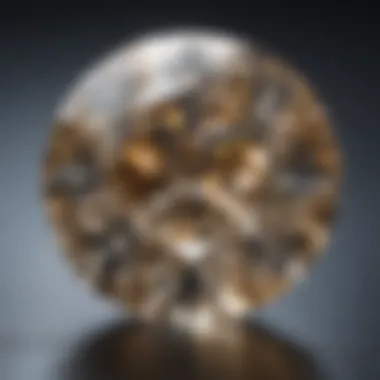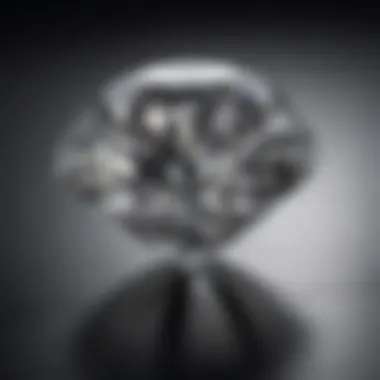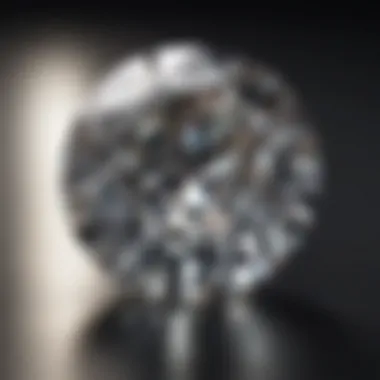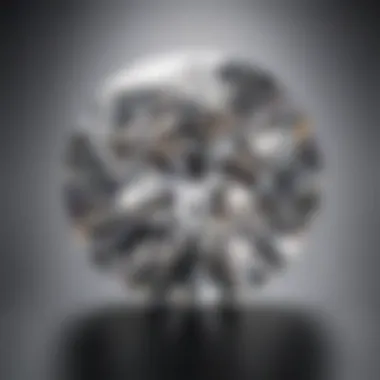The 1.25 Round Diamond: A Comprehensive Analysis


Intro
The examination of the 1.25 round diamond offers a blend of profound aesthetic appeal and intricate market dynamics. This gem has established itself as a significant player in the realm of fine jewelry. Understanding its key characteristics, cultural implications, and ethical dimensions paves the way for a thorough appreciation of this unique diamond.
Gemstone Overview
In the study of gemstones, it is essential to define the 1.25 round diamond. This specific gem is renowned for its brilliance and size, striking a balance in the hierarchy of diamond carat weights. Beyond the mere number, it embodies a complex collection of traits that define its identity in the gemstone market.
Definition and Characteristics
The term "1.25 round diamond" designates a diamond with a total carat weight of 1.25. Its round shape is a classic cut, optimized for maximum sparkle and reflection. Factors such as cut quality, color, and clarity significantly influence its perceived value.
Key Characteristics:
- Cut Quality: A well-cut diamond reflects light beautifully.
- Color Grade: Ranges from colorless to light shades, impacting price.
- Clarity Rating: Determines the presence of inclusions, influencing beauty and value.
Classification of Gemstones
Gemstones fall into various categories based on their characteristics and usage. The 1.25 round diamond is classified as a precious gemstone. This classification arises from its rarity, economic value, and cultural significance.
Properties of Gemstones
Every gemstone possesses distinct properties that define its nature and use. For the 1.25 round diamond, both physical and chemical properties come into play.
Physical Properties
The physical properties of diamonds include hardness and brilliance. Diamonds rank 10 on the Mohs scale of hardness, making them the hardest known natural material. This durability enhances their desirability for various uses in jewelry.
Physical Characteristics:
- Hardness: Rated as the hardest gemstone.
- Light Dispersion: Exhibits brilliance and fire, captivating observers.
- Luster: Known for incredible surface shine.
Chemical Properties
Chemically, diamonds are composed of carbon atoms arranged in a crystal lattice. This structure not only contributes to their hardness but also affects how they interact with light.
Chemical Composition:
- Element: Carbon (C)
- Bonding: Strong covalent bonds create the diamond's unique strength.
"Diamonds are a symbol of eternal love, yet their essence also lies in their scientific uniqueness."
As we delve deeper into the analysis of the 1.25 round diamond, we will explore the market trends and the broader cultural context that surrounds this remarkable stone.
Prelude to the Round Diamond
The round diamond holds a unique position within the world of gemstones, combining aesthetic appeal and technical precision. Appreciated for its brilliance and symmetry, the round cut often dominates the market, particularly in engagement rings and fine jewelry. Understanding the nuances of round diamonds is essential for both enthusiasts and professionals in the field, as insights into their characteristics and significance can influence purchasing decisions, design choices, and investments.
Definition and Characteristics of Round Diamonds
Round diamonds, chiefly known for their circular silhouette, are cut to maximize light return, enhancing their brilliance. This cut is based on advanced mathematical principles that dictate how light interacts with the stone. A well-cut round diamond has 58 facets, which serve to capture and refract light in a way that creates a stunning sparkle.
The primary characteristics that define round diamonds include:
- Brilliance: The quality of light reflection that gives the diamond its unique sparkle.
- Fire: The dispersion of light into colors, enhancing visual appeal.
- Scintillation: The sparkle effect produced when the diamond moves or a light source changes.


Round diamonds are categorized into various qualities, including cut, color, clarity, and carat weight, commonly referred as the Four Cs in the diamond grading system. Each aspect plays a critical role in determining both the aesthetics and the value of the gemstone.
Understanding Carat Weight
Carat weight is an essential factor when discussing diamonds, as it directly correlates with size and ultimately, value. A carat is a unit of measurement used to define a diamond's weight, equivalent to 200 milligrams. However, carat weight does not alone determine a diamond's appearance. For instance, two diamonds can be the same carat weight but look different based on their cut and proportions.
When considering carat weight, factors to bear in mind include:
- Visibility: A diamond’s visual size can vary significantly with the same carat weight, depending on its cut.
- Price: Generally, prices escalate as carat weight increases due to the rarity of larger stones.
- Consumer Preferences: Many buyers prefer poignant sizes, like the 1.25 carat, which offer a balance of size and affordability.
The Significance of 1. Carats in Diamond Selection
Selecting a diamond involves more than just choosing a piece of stone; it is about understanding its value, both emotional and financial. The 1.25 carat diamond occupies a unique space in this discussion. It is often regarded as an ideal choice for many consumers. This section explores why this specific carat weight holds particular significance in diamond selection.
Why 1. Carats is a Popular Choice
The popularity of the 1.25 carat diamond stems from various factors. First, it is perceived as the perfect balance between size and affordability.
- Visual Impact: A diamond of this size displays a substantial visual presence without going into excessive costs associated with larger weights.
- Symbolism: Many people see it as a suitable symbol for significant milestones in life, such as engagements or anniversaries.
- Market Trends: Demand for 1.25 carat diamonds is consistently high, partially due to effective marketing strategies by jewelers.
Some customers find that the price jump between 1.0 carats to 1.25 carats is more manageable than from 1.5 carats. Thus, it captures attention for those who desire elegance without overspending. Furthermore, many jewelers highlight 1.25 carat diamonds as part of their offerings, thus increasing visibility to consumers.
Comparing 1. Carat Diamonds to Other Sizes
When comparing 1.25 carat diamonds to different sizes, it's crucial to consider several aspects that influence their selection.
- Visual Size: A 1.25 carat diamond appears larger than it weighs due to its cut, thus providing excellent sparkle and brilliance. This can create the impression of higher value.
- Cost-Effectiveness: While a 1.25 carat diamond is more expensive than smaller options, it often costs less disproportionally compared to diamonds of 1.5 carats or more. This makes it a logical choice for budget-conscious buyers who do not want to compromise on beauty.
- Market Availability: The frequency of 1.25 carat diamonds available in the market means buyers can find a range of options in terms of shape, cut, and settings, whereas larger stones can be rarer.
In summary, the 1.25 carat diamond strikes a balance between emotional significance and practical considerations in both financial and aesthetic terms.
The Four Cs: Critical Factors Affecting Quality and Value
Understanding the value of diamonds stems from a conceptual framework known as the "Four Cs". This framework includes cut, color, clarity, and carat weight. Each of these attributes plays a significant role in determining the overall quality and value of a 1.25 round diamond. As consumers increasingly seek refined options for engagement rings or fine jewelry, grasping these factors becomes imperative for making informed decisions.
Analyzing the Four Cs not only equips diamond enthusiasts with essential knowledge but also aids jewelers and collectors in appraising and selecting gems that cater to aesthetic preferences and investment purposes.
Cut: The Most Important
The cut of a diamond is often regarded as the most crucial factor among the Four Cs. This element reflects how well the diamond has been shaped and faceted, directly influencing its brilliance and fire. A well-cut diamond will interact optimally with light, producing a dazzling display.
There are various styles of cuts, including brilliant, princess, and emerald, each with unique characteristics. A round diamond, especially in the 1.25 carat range, typically features a brilliant cut. This cut is designed with symmetry and proportion to maximize sparkle. When evaluating cut quality, factors such as depth, table size, and facet arrangement come into play.
A diamond's cut can be graded from Excellent to Poor, and this grading significantly affects its price. Understanding these nuances can empower buyers to select a diamond that not only fits their taste but also represents a sound investment.
Color: Assessing Diamond Color Grading
Color in diamonds refers to the presence of hue, which can affect the gem's value. Diamonds are graded on a color scale that ranges from D (colorless) to Z (light yellow or brown). In the realm of 1.25 round diamonds, color grading is critical. A colorless diamond tends to be more sought after due to its pristine nature.
Through careful assessment, one can determine the subtle color differences that might not be obvious to the untrained eye. Most buyers prefer diamonds in the G-H range for their near-colorless appearance and value retention.
A reputable gemological laboratory, such as the Gemological Institute of America (GIA), provides clarity in color grading. Buyers should prioritize certified diamonds to ensure their purchase meets stated color standards.
Clarity: Understanding Inclusions and Blemishes
Clarity encompasses the absence of inclusions and blemishes within the diamond. Inclusions are internal flaws, while blemishes are external. Clarity grades range from Flawless (no inclusions visible even under 10x magnification) to Included (inclusions visible to the naked eye).
For a 1.25 round diamond, clarity can greatly impact desirability and price. Diamonds with higher clarity are rarer and, thus, tend to command premium valuations. However, some diamonds may possess slight inclusions that do not significantly detract from overall beauty. Understanding the balance between clarity and value is key to selecting a diamond that meets personal and investment criteria.


Carat Weight: More Than Just a Number
Carat weight is a quantifiable measure indicating the diamond's size. One carat equals 200 milligrams. However, it is essential to note that carat weight alone does not determine a diamond's value. Two diamonds of equal carat weight can have vastly different values due to variances in cut, color, and clarity.
The 1.25 round diamond is a popular choice as it combines size with an appealing price point. Buyers should be aware that as diamond size increases, the price per carat can rise steeply due to rarity.
Hence, purchasing a diamond should involve more than focusing solely on carat weight; considering the interplay of the Four Cs enhances the decision-making process.
Market Trends for 1. Round Diamonds
Market trends for 1.25 round diamonds are essential for understanding their positioning in the fine jewelry market. The dynamics of pricing, demand, and consumer preferences reveal much about how these diamonds are perceived and valued. Analyzing these trends can guide both buyers and sellers in making informed decisions. This section will delve into recent pricing trends, the economic factors influencing diamond values, and shifting consumer preferences related to 1.25 round diamonds.
Current Pricing and Economic Factors
The pricing of a 1.25 round diamond hinges on various factors, with the Four Cs playing a vital role: cut, color, clarity, and carat. On average, the market price typically ranges between $8,000 and $12,000, depending on its specific characteristics. fluctuations in pricing can relate to several economic factors.
- Economic Climate: Economic stability influences consumer confidence. When the economy is robust, jewelers often see increased sales as luxury goods become more appealing. Conversely, in a downturn, consumers may prioritize essential purchases over luxury items.
- Supply and Demand: The rarity of high-quality diamonds drives demand. Diamonds that are GIA certified often hold higher value in the market. Limited supply months may also contribute to increased prices during high-demand seasons like wedding proposals or anniversaries.
- Competitor Pricing: As more jewelers enter the market, competitive pricing strategies can shift average market prices. Evaluating competitor rates helps stay abreast of current valuation trends.
Evaluating these economic factors allows potential buyers to determine the right time to invest in a 1.25 round diamond.
"Understanding market trends helps consumers make informed choices that fit their budget and preferences."
Consumer Preferences and Buying Patterns
Consumer preferences play a major role in the market for 1.25 round diamonds. Analyzing buying patterns reveals insights into what drives decisions in purchasing.
- Rise of Online Shopping: Online platforms have fundamentally changed how buyers access diamonds. Many consumers prioritize convenience and transparency leading them to compare prices easily across various websites. This trend has urged traditional jewelers to enhance their online presence.
- Personalization Trend: More buyers are looking for unique attributes in their diamonds. Customization allows for personal expression, leading to specific demands in cut and design that sellers must accommodate.
- Awareness of Ethical Sourcing: As the younger generations become more involved in the jewelry market, there is a growing preference for ethically sourced diamonds. Consumers often seek certification verifying that their diamonds are conflict-free, impacting their buying decisions significantly.
Cultural and Historical Context of Diamonds
Understanding the cultural and historical context of diamonds is crucial in appreciating their significance in society. Diamonds have been cherished for centuries, resulting in a profound impact on human emotion, power, and wealth. This section will highlight how diamonds have evolved from ancient symbols of durability and invincibility to modern manifestations of love and status.
Diamonds in Ancient Civilizations
In ancient civilizations, diamonds were more than decorative stones; they held sacred meanings. The earliest mentions of diamonds come from India, where they were mined over 2,000 years ago. They were valued not just for their beauty but also believed to possess protective qualities. Often used as talismans, diamonds were thought to confer strength and bring good fortune to their owners.
The Greeks considered diamonds to be the tears of the gods, linking them to divine representation in their mythology. The word "diamond" originates from the Greek word "adamas," meaning invincible, reinforcing the idea of their unbreakable nature.
In Ancient Rome, diamonds were worn by warriors in battle, symbolizing invincibility while also denoting status. Egyptian pharaohs adorned themselves with diamonds, associating these gems with royalty and divinity. This early appreciation lays the groundwork for the pervasive allure diamonds maintain even today.
Role of Diamonds in Modern Culture
Fast forward to today, diamonds occupy a prominent place in modern culture and society. The diamond engagement ring is a powerful emblem of love and commitment, rooted in the 20th century's marketing campaigns, particularly by De Beers. This has fostered an enduring belief that a diamond is essential for expressing romantic commitment.
In the realm of luxury, diamonds continue to symbolize wealth and status. They are prevalent in high fashion, worn by celebrities and often showcased in major public events. The presence of diamonds in films and fashion further cements their status as a cultural icon.
Moreover, diamonds also evoke significant cultural references. For instance, the phrase "diamonds are forever" has embedded itself into society's consciousness, emphasizing a diamond's longevity and value. This continues to influence consumer perceptions.
Additionally, modern discussions around diamonds have included ethical considerations, particularly concerning their sourcing and environmental impact. Ethical considerations are invaluable in current consumer decisions, manifesting a shift towards responsible purchasing and advocacy for conflict-free diamonds.
Diamonds, once symbols of divine strength, have become icons of love, commitment, and sometimes even conflict, illustrating their complex narrative through centuries.
In summary, the cultural and historical significance of diamonds shapes their value beyond mere aesthetics. Recognizing this context not only enriches the appreciation of these gems but also informs discussions around their ethical implications in contemporary society.
Ethical Sourcing of Diamonds
The topic of ethical sourcing in the diamond industry has gained significant visibility in recent years. This section focuses on the importance of sourcing diamonds ethically, especially when it comes to the 1.25 round diamond. Ethical sourcing ensures that the diamonds are obtained responsibly and do not contribute to human rights abuses or environmental degradation. For consumers, understanding the implications of ethical sourcing can guide purchasing decisions and align them with personal values.


Prioritizing ethical sourcing presents several benefits: it can enhance consumer trust, promote sustainable practices within the industry, and mitigate the risk of supporting financial conflicts. By buying ethically sourced diamonds, consumers may help foster positive change in mining communities, promoting fair labor practices and local economic development.
As the jewelry market evolves, it becomes imperative to consider these factors while choosing a diamond. Moreover, making informed decisions about diamond purchases can contribute to a greater demand for ethically sourced gemstones.
Understanding Conflict Diamonds
Conflict diamonds, often referred to as blood diamonds, are diamonds mined in war zones and sold to finance armed conflict against governments. Their sale has funded severe human rights abuses, often involving forced labor and violence. The extraction of these diamonds tragically impacts the local communities and environment.
To combat this issue, various international frameworks have been established, such as the Kimberley Process Certification Scheme. It aims to ensure that diamonds imported and exported are conflict-free. However, shortcomings still exist within this framework, and transparency remains a significant challenge. Some key points regarding conflict diamonds include:
- Economic Impact: Profits from conflict diamonds contribute to ongoing violence and instability in conflict-affected regions.
- Human Rights Violations: Many workers in diamond mines are subject to harsh conditions, often lacking fair compensation and safety measures.
- Environmental Damage: The mining process can lead to significant environmental degradation, affecting entire ecosystems.
Certification and Standards for Ethical Sourcing
Various certifications aim to promote and ensure the ethical sourcing of diamonds. Industry standards play a critical role in reinforcing consumer confidence and fostering transparency.
The following are some notable certification systems:
- Kimberley Process Certification: This initiative seeks to prevent the trade in conflict diamonds. It requires that participating countries certify their diamonds as conflict-free.
- Responsible Jewellery Council (RJC): The RJC promotes responsible ethical, human rights, social, and environmental practices throughout the diamond supply chain.
- Fair Trade Mining: This certification ensures that diamonds are mined under fair labor conditions and that local communities benefit economically.
It is essential for consumers to look for diamonds certified under these standards, as this not only provides assurance regarding the ethical origins of their purchase but also contributes to the broader cause of responsible mining practices. While certifications help, ongoing scrutiny and improvement of these systems are necessary to adapt to changing market conditions and demands.
Care and Maintenance of Round Diamonds
Caring for a diamond is crucial to maintaining its beauty and value over time. Regular maintenance not only keeps the diamond looking its best but also preserves its structural integrity. The 1.25 round diamond, like other gemstones, requires attention to detail in both cleaning and storage. Such practices can enhance the diamond's brilliance and ensure that it remains a cherished piece for generations.
Cleaning and Upkeep
Cleaning a 1.25 round diamond should be done regularly to remove dirt and oils that can accumulate. This is especially important if the diamond is set in a ring or other jewelry that is worn daily. The use of a soft brush and a mixture of warm water with mild dish soap often suffices for basic cleaning.
- Soak: Begin by soaking the diamond in this solution for about 20 to 30 minutes.
- Brush: Gently use a soft toothbrush to remove any debris, especially around the settings where dirt gathers.
- Rinse: After brushing, rinse thoroughly under warm running water.
- Dry: Use a lint-free cloth to pat the diamond dry, ensuring no moisture is trapped in the setting.
For deeper cleaning, consider taking the diamond to a professional jeweler for an ultrasonic clean. This method utilizes high-frequency sound waves, agitating the cleaning solution for an effective clean. However, it is essential to discuss with the jeweler first, as some settings may not be suitable for ultrasonic cleaning.
Proper cleaning is vital to maintain the diamond's sparkle and appearance. Neglect can lead to a dull stone, diminishing its visual appeal.
Storage Solutions
Storing a 1.25 round diamond properly is as vital as cleaning it. Improper storage can lead to scratches or damage. Here are some recommended storage practices:
- Use a Fabric Pouch: Each piece of diamond jewelry should be stored in its own fabric pouch to prevent scratching from other pieces.
- Separate Compartments: Utilize a jewelry box with separate compartments for diamonds and other gemstones. This minimizes the risk of contact that can cause damage.
- Avoid Moisture: Store diamonds in a dry place. Excessive moisture can result in tarnish on metal settings or even cause damage over time.
In summary, proper care and maintenance of round diamonds involve regular cleaning and appropriate storage practices. By undertaking these measures, jewelry owners can keep their diamonds in optimal condition, preserving both their aesthetic qualities and long-term value.
End: The Enduring Appeal of the 1. Round Diamond
The 1.25 round diamond holds a distinctive place in the market of fine jewelry. Its balanced carat weight delivers a compelling combination of size, brilliance, and affordability. As this analysis demonstrates, its significance extends beyond mere aesthetics to broader considerations of value, cultural importance, and ethical sourcing. Through this exploration, readers will gain a comprehensive understanding of the allure that keeps the 1.25 round diamond at the forefront of consumer choice.
Reflection on Its Value
The value of a 1.25 round diamond is shaped by several factors. Firstly, its carat weight creates a visual impact that appeals to many buyers, making it an attractive option for engagement rings and other significant jewelry pieces. Round diamonds are generally known for their scintillation and fire, qualities that become increasingly perceptible as the size increases.
Moreover, the four Cs—cut, clarity, color, and carat weight—play a vital role in determining value. A well-cut 1.25 round diamond can appear larger than its weight suggests, enhancing its visual presence without an exponential increase in cost. Clarity and color grades also contribute significantly; a higher clarity grade can increase desirability substantially,
Adding to its value is the cultural resonance of diamonds as symbols of love, commitment, and status. The 1.25 round diamond has successfully integrated itself into this narrative, combining size with significance.
Future Prospects for Round Diamonds
Looking ahead, the market for round diamonds, particularly the 1.25 carat, appears promising. Historically, diamonds have weathered economic fluctuations well, suggesting continued demand. Changing consumer preferences, such as a growing awareness of ethical sourcing, could drive future trends in this segment.
As more consumers become informed about the origins of their diamonds, the emphasis on ethical considerations is likely to increase. This shift may favor the 1.25 round diamond, especially if vendors promote their adherence to high sourcing standards.
Additionally, innovations in lab-grown diamonds might impact the market. These alternatives offer consumers an environmentally friendly and potentially less expensive option, creating competition for mined diamonds, including the compelling 1.25 round variant. However, natural diamonds remain unique; their irreplaceable nature is likely to ensure their continued popularity, especially in the luxury market.



